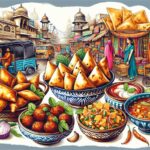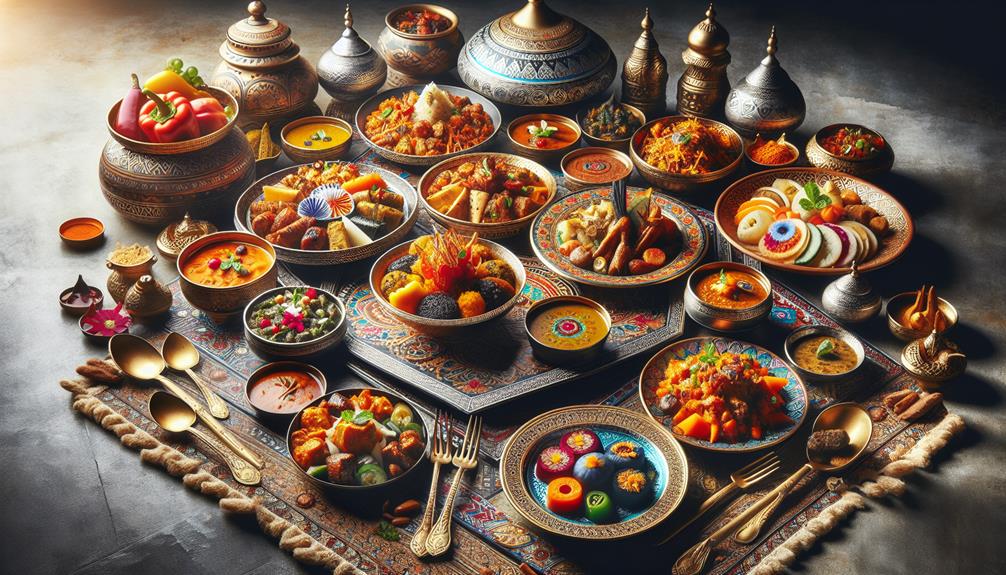
Popular Ingredients in North Indian Cooking: Spices, Herbs, and Staples
July 5, 2024
Samosas Delivered Hot: The Best Indian Appetizers at Your Doorstep
July 9, 2024Exploring the regional variations in North Indian food reveals a panorama of flavor profiles and culinary techniques shaped by geographical, historical, and cultural influences. Punjab’s rich, creamy dishes, accentuated by lush dairy farms, contrast sharply with Kashmir’s sophisticated use of spices and nuts, reflecting its historical trade connections and cooler climate. Meanwhile, Rajasthan’s cuisine, born of necessity in a harsh desert environment, makes ingenious use of local ingredients and preservation methods. Each region not only presents a distinct palette of tastes but also tells the story of its people and their adaptation to the land’s offerings. As we compare these culinary landscapes, it becomes apparent how deeply food is intertwined with cultural identity and survival.
Exploring Punjab’s Culinary Delights
Punjab, the breadbasket of India, offers a rich tapestry of flavors characterized by robust spices, hearty ingredients, and a generous use of dairy products in its culinary traditions. The fertile plains of the region contribute to an abundant production of wheat, rice, and dairy, elements that form the backbone of Punjabi cuisine. This gastronomy is not just about satisfying hunger but celebrating community, with dishes that are often shared during vibrant festivals and family gatherings.
One cannot discuss Punjabi cuisine without mentioning its iconic butter chicken, a dish that perfectly encapsulates the melding of spices and creaminess, often enjoyed with freshly baked naan. Equally renowned are the hearty dals and vegetable preparations such as sarson da saag (mustard greens) paired with makki di roti (cornbread), which provide comfort and warmth during the cold months.
Moreover, Punjab’s culinary scene is incomplete without the mention of its street food. From Amritsari kulchas stuffed with potatoes and spices to the frothy delight of lassi, these dishes offer a taste of Punjabi generosity and hospitality, inviting everyone to partake in their rich culinary heritage and feel a sense of belonging in every bite.
Kashmir and Rajasthan: Distinct Flavors
Moving northward to the serene valleys of Kashmir and the arid landscapes of Rajasthan, we encounter culinary traditions that markedly contrast with each other, yet each offers unique flavors and experiences deeply rooted in their respective cultural and environmental contexts.
Kashmiri cuisine, often referred to as the food of the Himalayas, is renowned for its rich gravies and extensive use of dry fruits and saffron. A quintessential dish such as Rogan Josh speaks volumes about the region’s history with its aromatic use of spices like cardamom and cloves, simmered with tender lamb.
In stark contrast, the cuisine of Rajasthan thrives in its minimalistic use of water, heavily relying on milk, buttermilk, and clarified butter (ghee) to create rich and hearty dishes reflective of the arid climate. The iconic Ker Sangri and Dal Baati Churma are not only staples but also embody the spirit of Rajasthani resilience and ingenuity in culinary practices.
Each cuisine, with its unique ingredients and methods, invites enthusiasts to explore and embrace these diverse culinary landscapes. Engaging with these dishes provides not just a taste but an insight into the lives and traditions of the people, fostering a deeper connection and appreciation for India’s rich gastronomic heritage.
In conclusion, North Indian food exemplifies the intricate tapestry of India’s cultural diversity, with each region narrating its own gastronomic tale.
Consider the majestic Thar Desert, seemingly barren yet sustaining life and inspiring Rajasthan’s innovative culinary strategies. This resilience is mirrored in dishes like Dal Baati Churma, which uses minimal water yet bursts with flavor, symbolizing how regional cuisines adapt and thrive, weaving historical and environmental influences into the rich fabric of Indian culinary heritage.
Prev article
